You can easily create eco-friendly homemade tea filters with just a few supplies and simple techniques. Start by choosing natural fabrics like organic cotton, hemp, or linen for durability and flavor neutrality. Cut your fabric into desired shapes, then sew the edges using food-safe thread. Customize your filters with embroidery or natural dyes for a personal touch. These reusable filters offer cost savings, reduce waste, and allow for tailored sizes to suit different teas. Maintain them by rinsing after use and deep cleaning periodically. With proper care, your homemade filters can last for months or even years. Discover how to elevate your tea experience while minimizing environmental impact.
Benefits of Homemade Tea Filters
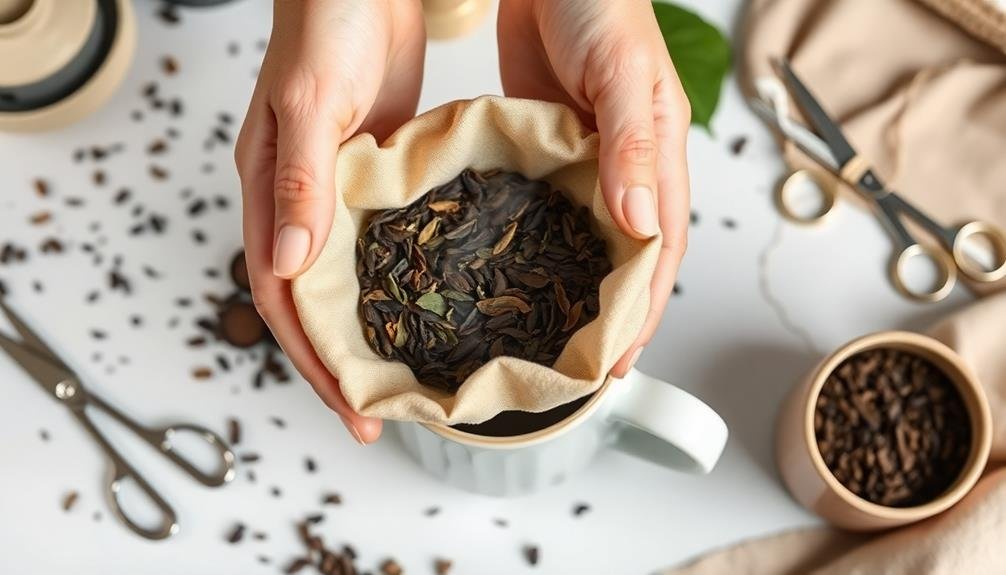
Brewing your own tea filters offers several advantages over store-bought options. You'll save money in the long run by creating reusable filters instead of constantly purchasing disposable ones.
These homemade filters are also more environmentally friendly, as they reduce waste and can be made from biodegradable materials.
You'll have greater control over the size and shape of your filters, allowing you to customize them for different tea types and brewing methods. This flexibility means you can create filters that fit perfectly in your teapot or cup, ensuring ideal infusion.
Homemade tea filters often allow for better flavor extraction compared to mass-produced options. You can choose materials that don't impart unwanted tastes or odors to your tea, resulting in a purer drinking experience.
By making your own filters, you'll avoid potential harmful chemicals found in some commercial products. You'll know exactly what materials are coming into contact with your tea, giving you peace of mind about what you're consuming.
Lastly, creating your own tea filters can be a fun and rewarding DIY project, allowing you to express your creativity and personalize your tea-drinking ritual.
Materials Needed
To make your own tea filters, you'll need some essential eco-friendly supplies.
Consider reusable fabric options like cotton, muslin, or hemp for a sustainable choice.
Don't forget about sustainable packaging materials to store your homemade filters, such as glass jars or biodegradable bags.
Essential Eco-Friendly Supplies
Five essential eco-friendly supplies are needed to create your own DIY tea filters. You'll need organic cotton fabric, hemp twine, beeswax, pinking shears, and a reusable metal tea infuser. The organic cotton fabric serves as the main material for your filters, guaranteeing a chemical-free brewing experience. Hemp twine is perfect for securing the filters, as it's biodegradable and durable. Beeswax helps waterproof the fabric and adds a natural seal. Pinking shears create a zigzag edge that prevents fraying, extending the life of your filters. Finally, a reusable metal tea infuser acts as a template for sizing your filters.
| Supply | Purpose | Eco-Friendly Feature |
|---|---|---|
| Organic Cotton Fabric | Main filter material | Chemical-free, biodegradable |
| Hemp Twine | Secures filters | Biodegradable, durable |
| Beeswax | Waterproofing | Natural, renewable |
| Pinking Shears | Prevents fraying | Extends filter lifespan |
| Metal Tea Infuser | Sizing template | Reusable, long-lasting |
These eco-friendly supplies guarantee your DIY tea filters are sustainable and environmentally conscious. By choosing these materials, you're reducing waste and creating a more eco-friendly tea-drinking experience. Remember to source your supplies from reputable vendors who prioritize sustainability in their production processes.
Reusable Fabric Options
Now that you've gathered your eco-friendly supplies, let's focus on the reusable fabric options for your DIY tea filters. You'll want to choose materials that are durable, heat-resistant, and free from harmful chemicals.
Cotton is an excellent choice, as it's natural, breathable, and easy to clean. Organic cotton is even better, guaranteeing you're not exposing your tea to pesticides.
Unbleached muslin is another fantastic option, offering a fine weave that'll prevent tea leaves from escaping while allowing flavors to infuse. For a more lightweight option, consider hemp fabric, which is naturally antimicrobial and becomes softer with each wash.
Linen is also a great choice, known for its strength and ability to withstand high temperatures.
When selecting your fabric, keep these factors in mind:
- Porosity: Guarantee the weave is tight enough to contain tea leaves but allows water to flow through.
- Durability: Choose fabrics that can withstand repeated use and washing.
- Taste neutrality: Opt for materials that won't impart their own flavors to your tea.
- Sustainability: Consider the environmental impact of the fabric's production and disposal.
Remember to pre-wash your chosen fabric to remove any residues and guarantee it's clean before use.
Sustainable Packaging Materials
For your DIY tea filters, you'll need sustainable packaging materials to store and transport them. Consider using small glass jars with airtight lids, which are durable and can be reused indefinitely. Mason jars or repurposed food containers work well for this purpose.
If you prefer a lighter option, look for small tins made from recyclable materials.
For a more flexible storage solution, try organic cotton drawstring bags. These breathable pouches allow air circulation while keeping your filters clean and organized. You can also use beeswax wraps, which are reusable and biodegradable alternatives to plastic wrap.
When it comes to labeling your tea filters, opt for eco-friendly options like bamboo or wooden tags tied with twine. Alternatively, use washable fabric markers to write directly on fabric filters or labels.
For gifting or selling your DIY tea filters, consider kraft paper boxes or bags made from recycled materials. These can be easily customized with stamps or natural dyes.
Remember to seal your packages with paper tape instead of plastic-based options to maintain the eco-friendly aspect of your project.
Choosing the Right Fabric

When selecting fabric for your DIY tea filters, you'll want to take into account natural options like cotton, linen, or hemp for their safety and flavor neutrality.
You should prioritize durability and reusability to guarantee your filters stand up to repeated use and washing.
Pay attention to the fabric's weave, as a tighter weave will prevent tea particles from escaping while allowing flavors to infuse properly.
Natural Fabric Options
Selecting the right fabric for your DIY tea filters is crucial for a successful brewing experience. When it comes to natural fabric options, you'll want to take into account materials that are both safe for food contact and effective at filtering tea leaves.
Cotton, linen, and hemp are excellent choices for eco-friendly, reusable tea filters.
Cotton is widely available and easy to work with, making it a popular option for beginners. It's soft, durable, and can withstand repeated use and washing.
Linen, derived from flax plants, offers superior filtration capabilities and becomes stronger when wet.
Hemp fabric is known for its durability and antibacterial properties, making it an ideal choice for long-lasting tea filters.
When choosing your natural fabric, keep these factors in mind:
- Porosity: Ascertain the weave is tight enough to filter fine tea particles
- Durability: Select fabrics that can withstand hot water and frequent washing
- Taste neutrality: Opt for materials that won't impart flavors to your tea
- Sustainability: Take into account the environmental impact of your chosen fabric
Durability and Reusability
Three key factors determine the durability and reusability of your DIY tea filter fabric: material strength, heat resistance, and washing endurance.
When selecting your fabric, opt for tightly woven cotton, linen, or hemp. These materials offer excellent strength and can withstand repeated use without tearing or fraying.
Heat resistance is vital, as your filter will come into contact with boiling water. Natural fibers like cotton and linen can handle high temperatures without breaking down or releasing harmful chemicals.
Avoid synthetic materials that may melt or leach toxins when exposed to heat.
Washing endurance is essential for maintaining hygiene and extending the life of your tea filters. Choose fabrics that can withstand frequent washing without losing their shape or effectiveness.
Cotton and linen are easy to clean and maintain their integrity even after multiple washes.
To maximize the lifespan of your DIY tea filters, rinse them thoroughly after each use and allow them to air dry completely.
Periodically wash them in hot water with mild soap to remove any buildup.
With proper care, your homemade tea filters can last for months or even years, reducing waste and saving you money in the long run.
Fabric Weave Considerations
The fabric weave of your DIY tea filter plays a vital role in its effectiveness and longevity. When choosing the right fabric, you'll want to take into account the tightness of the weave and its ability to retain fine tea particles while allowing flavors to infuse. A tight weave will prevent loose tea leaves from escaping into your cup, but it shouldn't be so dense that it impedes water flow.
Cotton muslin is an excellent choice for its fine weave and natural properties. Alternatively, you can opt for unbleached cheesecloth, which offers a slightly looser weave that's still effective for most tea types. Linen is another durable option, known for its strength and ability to withstand repeated use.
Take these factors into account when selecting your fabric:
- Porosity: Confirm the weave allows water to pass through easily
- Strength: Choose a fabric that won't tear or fray with frequent use
- Heat resistance: Select materials that can withstand boiling water
- Chemical-free: Opt for untreated, natural fabrics to avoid altering tea flavors
Cutting and Shaping
With your materials ready, it's time to cut and shape your DIY tea filters. Begin by measuring and marking your chosen fabric into squares or circles, depending on your preferred filter shape. For single-cup filters, aim for 4-5 inch squares or circles. If you're making larger filters for teapots, increase the size accordingly.
Use sharp fabric scissors to cut along your marked lines, ensuring clean edges. For circular filters, fold the fabric in half and cut a semicircle to achieve a perfect round shape when unfolded. If you're using a more delicate fabric, consider using pinking shears to prevent fraying.
Next, fold the edges of your cut fabric inward by about 1/4 inch and press with an iron to create a neat hem. For a sturdier filter, double-fold the edges. If you're making drawstring tea bags, leave a small opening at the top for the string.
To create pleats for better expansion during steeping, fold the fabric in accordion-style pleats and press with an iron. Secure the pleats with a few stitches at the top if desired.
Sewing Techniques
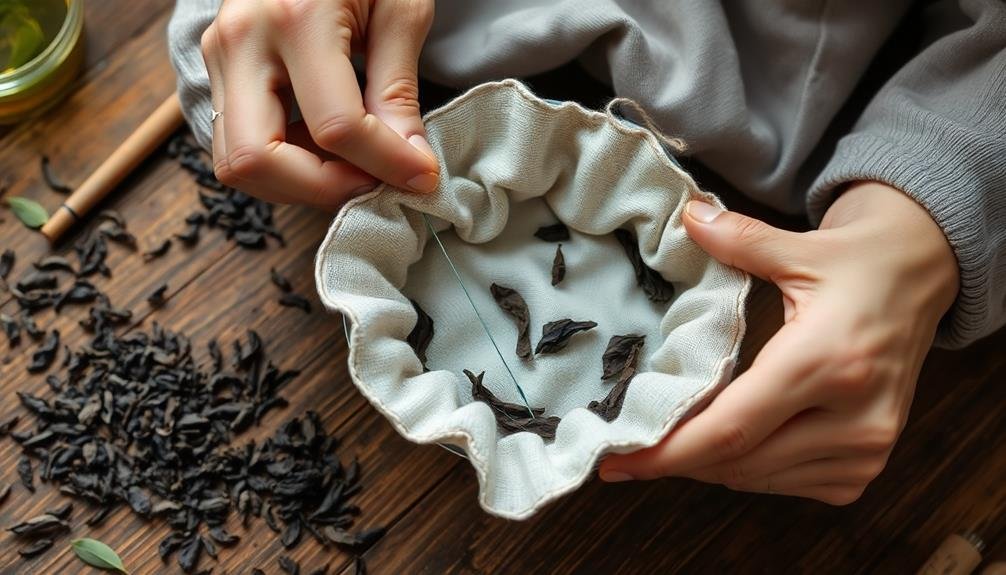
Now that you've shaped your filters, it's time to secure them with some simple sewing techniques. You'll need a needle, thread, and scissors. Choose a strong, food-safe thread like cotton or linen. Begin by threading your needle and tying a knot at the end.
Start sewing along the edge of your filter, using a simple running stitch. Keep your stitches small and evenly spaced, about 1/4 inch apart. When you reach a corner, make a few small stitches in the same spot to reinforce it. Continue around the entire edge of the filter, leaving a small opening for filling.
Once you've sewn most of the way around, turn the filter inside out through the opening. This will hide your stitches and create a neater appearance. Finally, hand-stitch the opening closed using a slip stitch for an invisible finish.
Here are four key benefits of properly sewn tea filters:
- Durability for multiple uses
- Even steeping of tea leaves
- Easy cleaning and maintenance
- Reduced environmental impact compared to disposable filters
Remember to double-check your stitches for any gaps or weak spots before using your homemade tea filter.
With practice, you'll create professional-looking, eco-friendly filters in no time.
Cleaning and Maintenance
Proper care of your homemade tea filters will guarantee their longevity and hygiene. After each use, rinse your filters thoroughly with warm water to remove any tea residue. Gently squeeze out excess water, but avoid wringing or twisting, which can damage the fabric. Hang them to air dry completely before storing.
For a deeper clean, wash your filters weekly. Use mild, unscented soap and lukewarm water. Gently hand wash, paying attention to any stained areas. Rinse thoroughly to remove all soap residue.
Never use harsh detergents or bleach, as these can affect the fabric's integrity and your tea's taste. If you notice stubborn stains, try soaking the filters in a mixture of warm water and baking soda for 30 minutes before washing.
For natural disinfection, boil the filters in water for 5 minutes once a month. Store your clean, dry filters in a breathable container to prevent moisture buildup and mold growth.
Inspect them regularly for signs of wear and tear, replacing them when necessary to guarantee the best tea-drinking experience.
Reusable vs. Single-Use Options

When choosing DIY tea filters, you'll face a key decision: reusable or single-use options. Reusable filters are eco-friendly and cost-effective in the long run. They're typically made from materials like cotton, linen, or fine mesh. You'll need to wash them after each use, but they'll last for months or even years.
Single-use options, on the other hand, are more convenient but generate more waste. These can be made from biodegradable materials like unbleached paper or cheesecloth.
Consider these factors when deciding between reusable and single-use DIY tea filters:
- Environmental impact: Reusable filters reduce waste, while single-use options contribute to landfills.
- Cost: Reusable filters have a higher upfront cost but save money over time.
- Convenience: Single-use filters are easier for travel or busy lifestyles.
- Taste: Some argue that reusable filters allow for better flavor extraction.
Ultimately, your choice depends on your priorities. If sustainability is your main concern, opt for reusable filters. If convenience is paramount, single-use options might be more suitable.
You can also use a combination of both, depending on the situation.
Eco-Friendly Packaging Ideas
Five eco-friendly packaging ideas can complement your DIY tea filters, enhancing your commitment to sustainability.
First, consider using small glass jars with airtight lids to store your filters. These jars are reusable, easy to clean, and preserve the freshness of your tea filters.
Second, opt for biodegradable paper bags made from recycled materials. They're lightweight, compostable, and perfect for gifting or travel.
Third, repurpose old tins or metal containers by cleaning them thoroughly and adding labels. These provide excellent protection and can be reused indefinitely.
Fourth, create fabric pouches using organic cotton or hemp. You can sew them yourself or find ready-made options, adding a personal touch with embroidery or natural dyes.
Finally, consider bamboo containers with sliding lids. They're durable, naturally antimicrobial, and biodegradable at the end of their lifecycle.
When choosing packaging, prioritize materials that are easily recyclable or compostable in your area.
Customizing Your Tea Filters
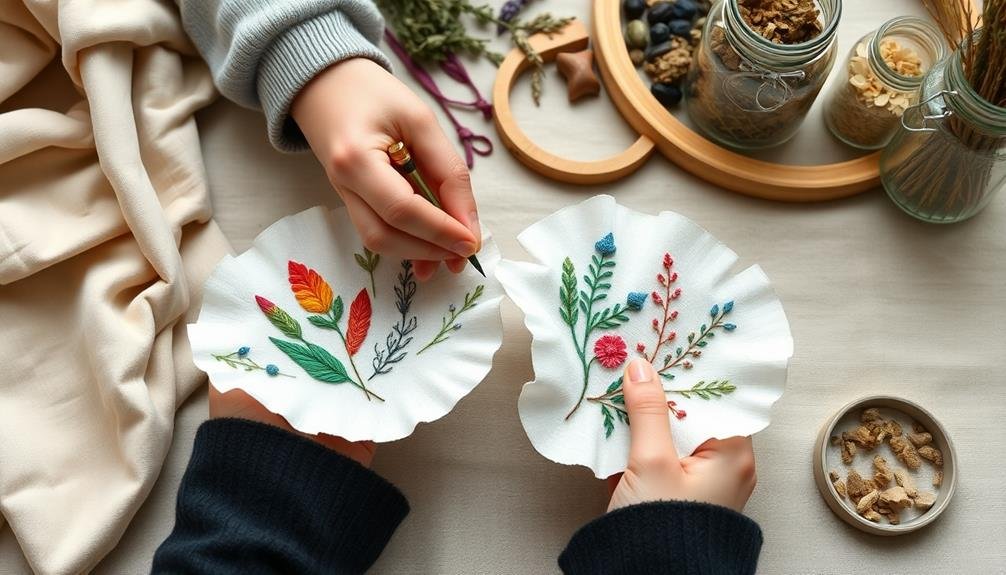
Customizing your tea filters allows you to create a unique and personalized tea experience. By adding your own touch to these eco-friendly filters, you're not only reducing waste but also enhancing your tea-drinking ritual.
Consider using different fabrics like organic cotton, muslin, or even repurposed linen for varied textures and filtration levels. You can also experiment with shapes and sizes to suit different cup styles or brewing methods.
To make your tea filters stand out, try embroidering them with colorful threads or adding small decorative elements like buttons or beads. Just make certain these additions don't interfere with the filter's functionality.
For a practical twist, attach a string or loop to make it easier to remove the filter from your cup.
Here are four ways customizing your tea filters can enhance your tea experience:
- Express your creativity and personal style
- Tailor the filtration level to your preference
- Match your filters to specific tea blends or occasions
- Create thoughtful, handmade gifts for fellow tea enthusiasts
Frequently Asked Questions
Can Homemade Tea Filters Be Used for Cold Brew Tea?
Yes, you can use homemade tea filters for cold brew tea. They'll work just as well as store-bought filters. Simply place your tea leaves in the filter, submerge it in cold water, and let it steep in the refrigerator overnight.
How Long Do Homemade Tea Filters Typically Last Before Needing Replacement?
You'll find that homemade tea filters typically last for 3-5 uses before needing replacement. However, their lifespan depends on the materials you've used and how well you clean them after each use. Don't forget to inspect them regularly.
Are There Any Fabrics to Avoid When Making Tea Filters?
You'll want to avoid synthetic fabrics like polyester or nylon for your tea filters. They can release harmful chemicals when exposed to hot water. Stick to natural materials like cotton, linen, or hemp for safe, eco-friendly options.
Can Homemade Tea Filters Be Used in Electric Tea Makers?
You can use homemade tea filters in electric tea makers, but be cautious. Guarantee they're sturdy enough to withstand the machine's heat and pressure. It's best to test them first and avoid using materials that might melt or disintegrate.
Are There Any Health Concerns Associated With Using Homemade Tea Filters?
You shouldn't worry about health concerns with homemade tea filters if you use safe, food-grade materials. However, be cautious of any chemicals or dyes in fabric. Always clean your filters thoroughly and replace them regularly for best hygiene.
In Summary
You've now got all the knowledge you need to create your own eco-friendly tea filters. By making this simple switch, you're reducing waste and enjoying a more sustainable tea-drinking experience. Don't be afraid to experiment with different fabrics and designs to find what works best for you. Remember, every small change counts, so keep exploring ways to make your daily routines more environmentally friendly. Happy brewing!


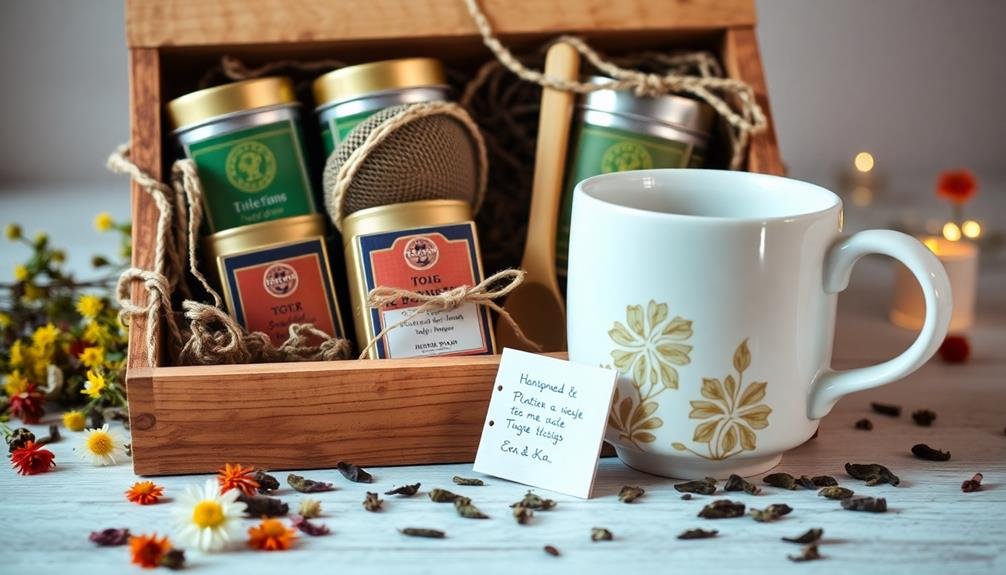
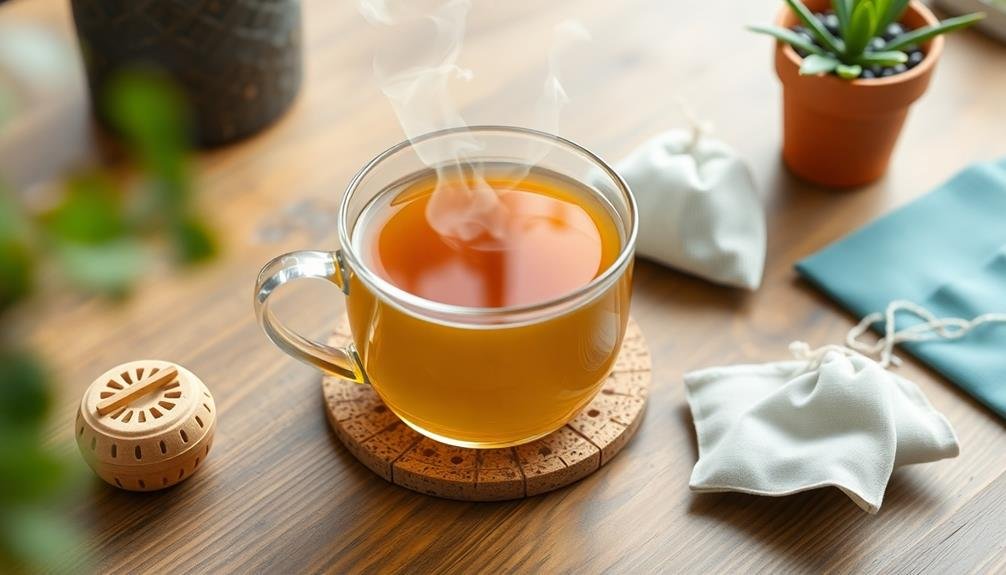
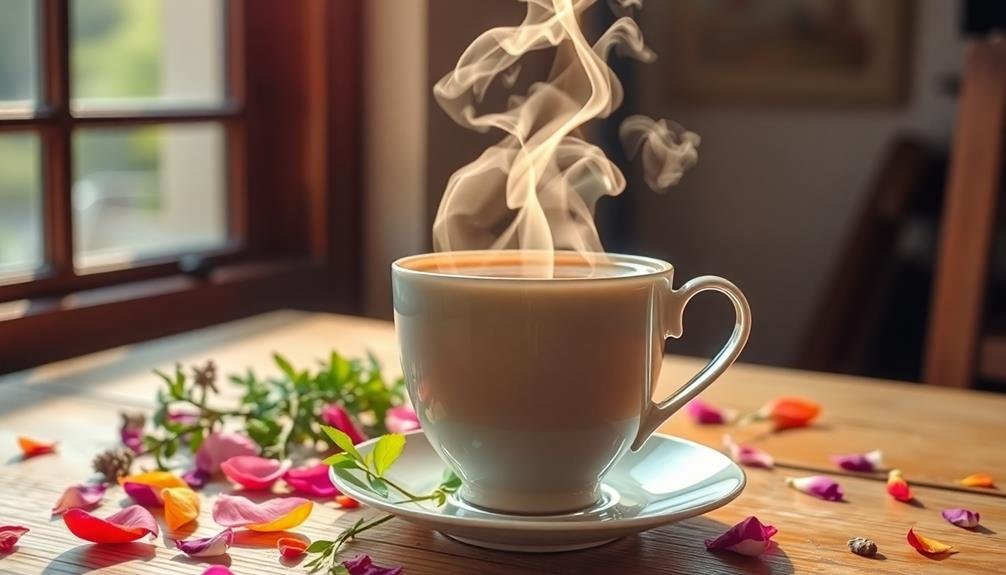
Leave a Reply